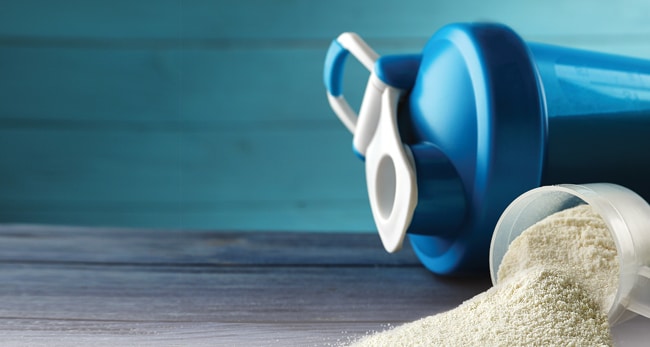Weighing Powders, By Brick and By Click
Functional powdered beverages have long been the domain of the specialty channel, led by protein and pre-workout products for fitness minded consumers. But over the past few years, the market for functional powdered beverages has shifted, moving outside of the specialty channel into a broader marketplace in brick and mortar retail and ecommerce. As well, many brands that built their core business in powders have now turned to ready-to-drink line extensions to expand their growth runway and reach new consumers by tapping into omnichannel opportunities.
According to John Herman, EVP and general manager for North America at Nutrabolt, the company estimates its C4 pre-workout powder line has roughly a 40% market share of the pre-workout subcategory and overall continues to grow in the mid-single digits. Though the company has looked to the RTD energy drink version of C4 as its growth leader since 2018, the powder business continues to evolve, he said, noting that in particular channels distribution for the category has changed drastically within the past two to three years.
Previously, Herman said, specialty channel accounts such as GNC and Vitamin Shoppe accounted for roughly 75% of pre-workout powder sales. But growth in that space has slowed and in Q2 of 2019 the combined grocery, drug, mass and ecommerce channels emerged as the majority shareholder of the category (a space where Nutrabolt is reporting double digit increases for its powders).
“We’ve seen this customer fluctuation where the specialty channel is experiencing declines and then the brands that have been able to diversify where they’re distributed have been able to maintain and outpace the growth of a category,” Herman said. “So the category may not have a ceiling, but growth is really about setting yourself up for where the customer will be.”
The shift is occurring, he added, because consumers are self-educating on the pre-workout category and are less reliant on the technical expertise provided in store at specialty retailers. Shoppers who either learn from the internet or are already repeat buyers are favoring convenience, whether that is purchasing online or getting their powder at the grocery store along with their kitchen essentials.
Nutrabolt has also taken a rising tides approach to its beverage business. Over the next three to five years, Herman said, scaling the C4 energy drink line will be the prime focus and the structure of the company will evolve around it. As the RTD format gains traction — particularly in channels beyond the reach of multi-serving powder formats, such as gas and convenience — he hopes that brand loyalty will improve and many consumers will become powder buyers.
“It can be the Smirnoff Ice impacting the Smirnoff vodka sales,” he said. “If we sell more beverage, we believe we will sell more powder, because people will just get that much more boost with the brand. And if you look at the sports nutrition category, specific to our traditional space, we’re a really big fish in a small pond. But if you look at the beverage opportunity and the size and scale of the energy category, we see tremendous upside for Nutrabolt to really interact with a completely new consumption moment and potentially a new consumer that hadn’t dealt with the brand before.”
Last year, powdered energy drink maker G Fuel launched its first RTD line in a push to expand its retail presence into convenience and conventional channel accounts. Launched in 2012, G Fuel’s primary business is online, targeting gamers by partnering with influencers such as prominent YouTubers and Twitch streamers. According to founder and CEO Clifford Morgan, consumers had long requested an RTD format and the company has now reached a size where it can support the expansion.
Morgan noted that while powders still make up the majority of G Fuel’s sales (and ecommerce at the moment accounts for 98% of the business), the RTD launch will help the brand to get both product lines — including tubs and single-serve sample kits — into retailers such as Walmart, while also opening the door to c-store partners such as 7-Eleven, WaWa and Circle K, which the brand added in Q1. Ultimately the goal is for retail to surpass ecommerce; however, according to COO Jack LoParco, G Fuel estimates 95% of that retail business will be liquid beverage.
“There is still a ton of room for us to grow in the powdered sector,” Morgan said. “And I think our opportunities are bigger now, as a bigger brand with a bigger reach, than they were even a year or two ago.”
While turning to RTD vastly expands the runway for powder makers, dry products continue to provide an easier and less risky format for innovation. At collagen brand Vital Proteins, Seidensticker said the company uses its robust manufacturing capabilities in conjunction with its ecommerce platform to try out new kinds of products with significantly lower costs and in less time than liquid product development. For example, Seidensticker noted that the company most recently developed an immunity boosting collagen peptide product that it launched in March. The product took only a few weeks to develop, he said, whereas it would have taken at least six months to launch the product in a ready-to-drink format.
“Because we’re vertically integrated and we have our own powder manufacturing facility, we can come up with an innovation within a matter of weeks, and bring it to market,” Seidensticker said. “The ecommerce platform provides that incubator to verify and give consumers access to that early innovation of products. It’s not as easy to innovate in beverage, it takes a little bit longer to develop a beverage and manufacture beverage, so some of the hero products [in powder] kind of evolve naturally into that category.”
Seidensticker said he sees beverage as “a tool for increasing household penetration,” noting that while powder will always remain a core piece of Vital Proteins’ platform, the convenience of RTD helps bring in new consumers.
“There are consumers who are going to take our powder and make a smoothie out of it or put the performance products in a shaker bottle,” he said. “But not everyone is a powder consumer. So now we’re talking about the convenience and grab and go factor beverage provides for people who are heading to the gym, or want their collagen water for hydration when they’re on the go.”
James Mayo, co-founder of powder stick brand SOS Hydration (which does not have an RTD line), said the company reports strong sales in ecommerce facilitated by the relatively low cost of shipping and has an overall 68% return customer rate, but still relies on field marketing in retail to drive trial. In addition to in-person sampling demos, consumers can typically purchase single sticks in grocery stores and try different flavors before committing to a more costly multi-pack purchase. But now that the six-year-old brand has established a loyal consumer base, Mayo said, SOS Hydration is working closely with Amazon and outside marketing agencies to expand its ecommerce presence and help bring retail buyers online.
“We’ve built a slow groundswell rather than just chucking straight into it,” Mayo said. “So we’ve got a lot of loyal consumers, and now it’s about using them. We’re expanding the ambassador program and expanding the opportunity to sample and get it into people’s hands and continue the education. ”
Betsy McGinn, founder of consulting firm McGinn eComm, frequently compares the difference between shipping powder and liquid beverages to basketballs and bowling balls; with the latter, logistics costs frequently result in razor thin margin, even among leading brands. Speaking with BevNET, McGinn noted that in the case of performance energy brand CELSIUS, a 14-pack of its powdered stick line sells on Amazon for roughly $12-13 per unit and can be fulfilled by the retailer for $3.30. But a 12-pack of CELSIUS’ Heat RTD line sells for about $29 and costs $9.80 for Amazon fulfillment.
“The sticks have positioned themselves at a price that a consumer is willing to try versus the RTD, which is not at a trial price,” McGinn said. “This is an advantage (the small and light factor), that can make a material difference in establishing a trial price point for the consumer, ultimately leading to building the foundation for a product.”
McGinn noted that while the top selling beverage item on Amazon is currently Essentia bottled water, the number four item is Orgain protein powder and numerous ground coffee brands fill out much of the Top 20. But while powder may still provide an advantage for brands looking to sell online, sales of RTD products continue to increase and companies have been able to “make the numbers work” through format innovation such as smaller pack sizes. But for now, ecommerce provides a robust platform for powder beverage brands to broaden their channel strategy.


Receive your free magazine!
Join thousands of other food and beverage professionals who utilize BevNET Magazine to stay up-to-date on current trends and news within the food and beverage world.
Receive your free copy of the magazine 6x per year in digital or print and utilize insights on consumer behavior, brand growth, category volume, and trend forecasting.
Subscribe
